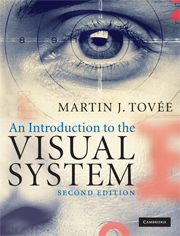Book contents
- Frontmatter
- Contents
- 1 Introduction
- 2 The eye and forming the image
- 3 Retinal colour vision
- 4 The organisation of the visual system
- 5 Primary visual cortex
- 6 Visual development: an activity-dependent process
- 7 Colour constancy
- 8 Object perception and recognition
- 9 Face recognition and interpretation
- 10 Motion perception
- 11 Brain and space
- 12 What is perception?
- References
- Index
- Plate sections
4 - The organisation of the visual system
Published online by Cambridge University Press: 05 June 2012
- Frontmatter
- Contents
- 1 Introduction
- 2 The eye and forming the image
- 3 Retinal colour vision
- 4 The organisation of the visual system
- 5 Primary visual cortex
- 6 Visual development: an activity-dependent process
- 7 Colour constancy
- 8 Object perception and recognition
- 9 Face recognition and interpretation
- 10 Motion perception
- 11 Brain and space
- 12 What is perception?
- References
- Index
- Plate sections
Summary
Making a complex process seem simple
Vision is the primary sensory modality in primates such as ourselves, and this is reflected in the complexity of the visual system and the extent of the cerebral cortex used for the analysis of visual information. On the basis of anatomical, physiological and behavioural studies, it is believed that at least 32 separate cortical areas are involved with the processing of visual processing in the macaque monkey (Van Essen et al., 1992). Twenty-five of these areas are primarily visual in function; the remaining seven are also implicated in other functions such as polysensory integration or visually guided motor control. These visual areas occupy about half of the 100cm2 area of each of the monkey's cortical hemispheres. Two of the areas, V1 and V2, each occupies more than 10cm2 of the cortical surface, but most visual areas occupy less than a tenth of this area. Comparatively little is known of the functional anatomy of the human visual cortex, but it seems to be at least as complex as that of the monkey (Kaas, 1992; Sereno et al., 1995). Fortunately, it is possible to simplify this picture by concentrating on the key visual areas and looking at their functional organisation.
As one moves up the visual system, from the retina to the lateral geniculate nucleus and then on to successive cortical areas, visual neurons become responsive to more and more complex stimuli.
- Type
- Chapter
- Information
- An Introduction to the Visual System , pp. 62 - 77Publisher: Cambridge University PressPrint publication year: 2008
- 1
- Cited by



